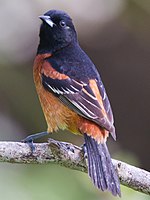Garden trupial
| Garden trupial | ||||||||||||
|---|---|---|---|---|---|---|---|---|---|---|---|---|

Garden Trupial ( Icterus spurius ), male |
||||||||||||
| Systematics | ||||||||||||
|
||||||||||||
| Scientific name | ||||||||||||
| Icterus spurius | ||||||||||||
| ( Linnaeus , 1766) |
The garden trupial ( Icterus spurius ) is a species of songbird from the starch family (Icteridae) found in North, Central and South America .
description
Appearance
Male garden trupials reach a total length of 15 to 18 centimeters. The weight varies between 16 and 25 grams. Adult males are colored black on the head, neck, upper chest area, neck and back as well as on the control feathers. The lower chest area, the belly, the flanks and the rump are colored bright red orange. The wings are primarily black, with the exception of a red-orange shoulder patch, a white wing band and a few white hand wings . There is a conspicuous sexual dimorphism , since the drawing of the females turns out to be much less contrasting and paler in color. They have a predominantly yellowish plumage. The back and the wings have an olive-brown or gray-green or brownish color. The iris is black-brown in both sexes. The bill, legs and feet are blue-gray.
Vocalizations
The singing of the garden trupial is a loud, melodic string of whistling tones. Occasionally a croaking "chatter" can be heard, which mostly serves as an alarm call.
Singing example 1
Singing example 2
distribution and habitat
The breeding areas of the garden trupials include the central south of Canada , the central and eastern US states and extend in the south to the north of Mexico . The wintering areas are further south and extend to Colombia and Venezuela . The species prefers to live in open forest landscapes, in gardens and parks as well as on the edges of rivers and lakes.
Way of life
The birds live in pairs, but usually breed in small colonies. They feed primarily on various insects, and occasionally berries , seeds, and flower nectar .
From February the garden trupials return from their winter quarters and will soon begin mating. The nest is made at the top of twigs or in forks of branches in the form of a hanging bag from plant fibers and elastic thin twigs. It is woven by the female within six days. The clutch number consists of two to seven eggs, which are mostly laid in May. The eggs are light blue in color and have a few small purple or brown spots. A second brood does not usually take place. The breeding season is 12 to 14 days. During this time, the female is provided with food by the male. Both parents feed the nestlings, which fly out after 11 to 14 days. In autumn, the birds retreat to their winter quarters in large groups.
Danger
The garden trupial is not uncommon in its areas of distribution and is therefore classified by the IUCN as a ![]() “ least concern ”. It is protected by the United States Fish and Wildlife Service under the Migratory Bird Treaty Act .
“ least concern ”. It is protected by the United States Fish and Wildlife Service under the Migratory Bird Treaty Act .
Subspecies
The following subspecies are distinguished:
swell
literature
- Richard Crossly: The Crossly ID Guide. Princeton University Press, 2011, ISBN 978-0-691-14778-9 , p. 500.
Individual evidence
- ↑ Distribution area
- ^ Animal Diversity Web
- ^ IUCN Red List
- ^ Migratory Bird Treaty Act
- ^ IOC World Bird List New World warblers & oropendolas
Web links
- sdakotabirds - photos


